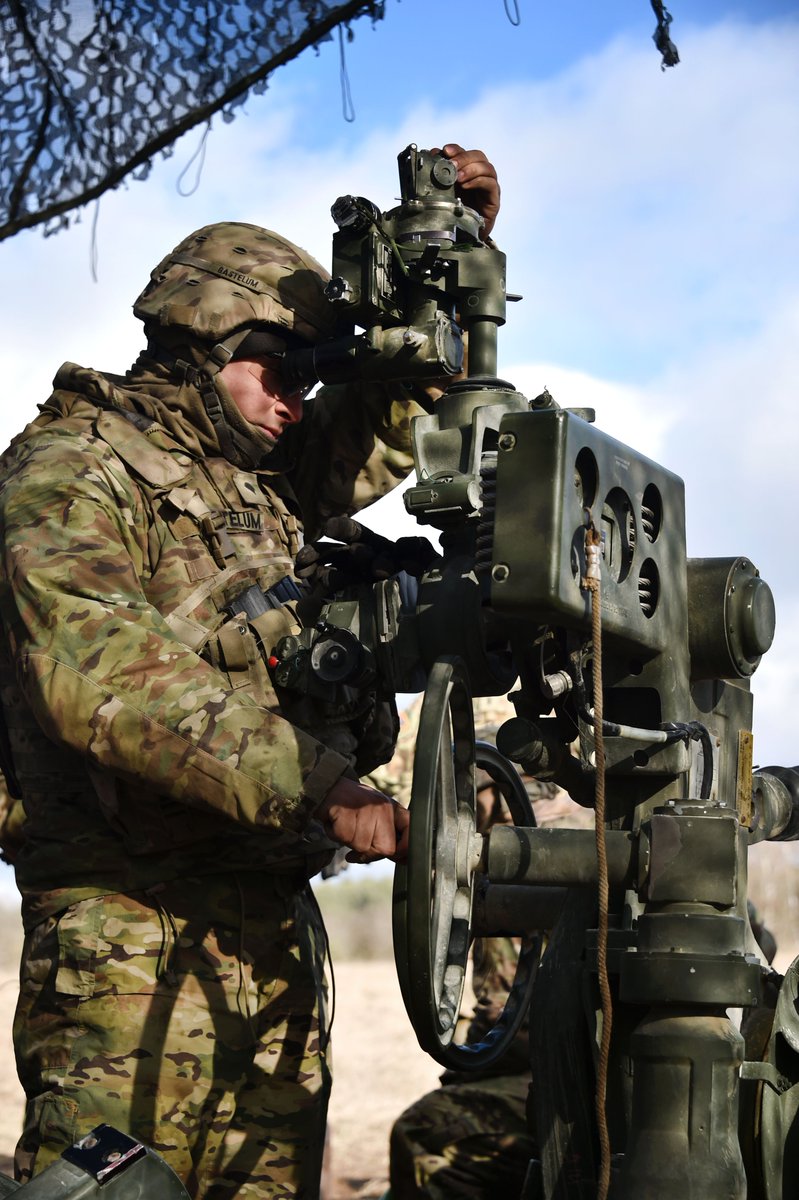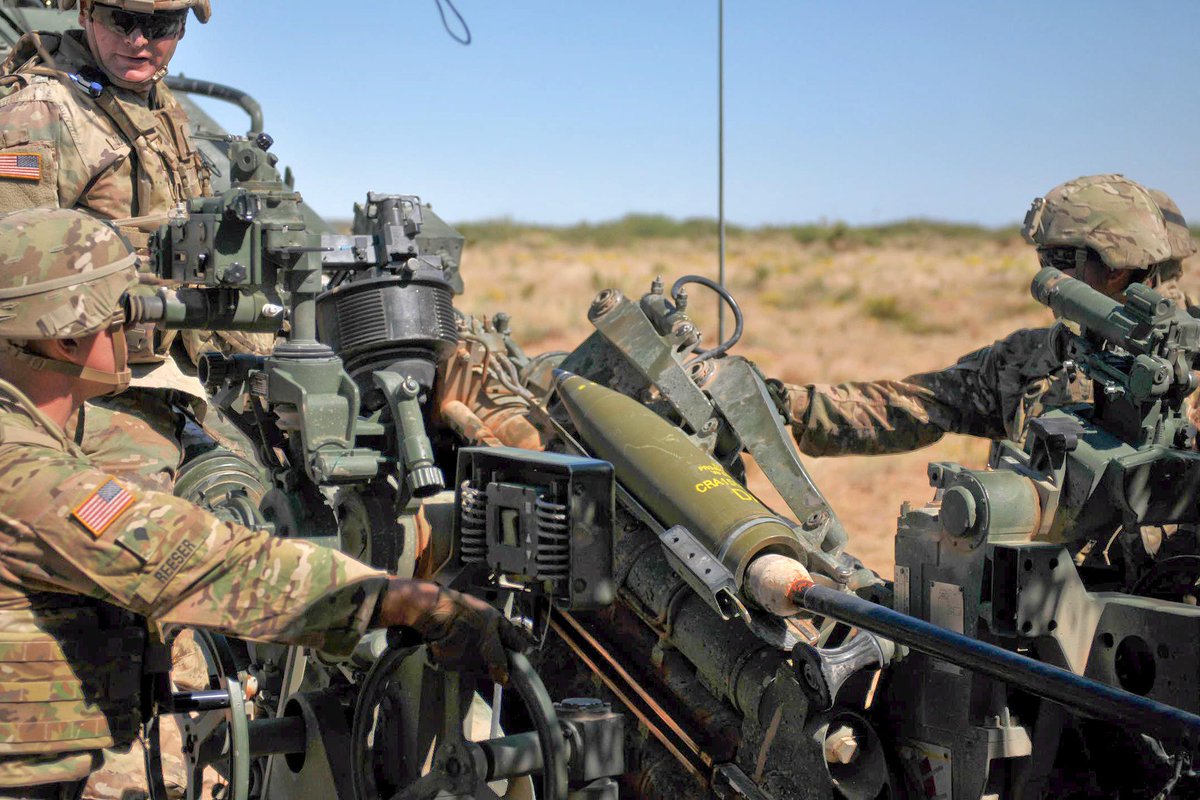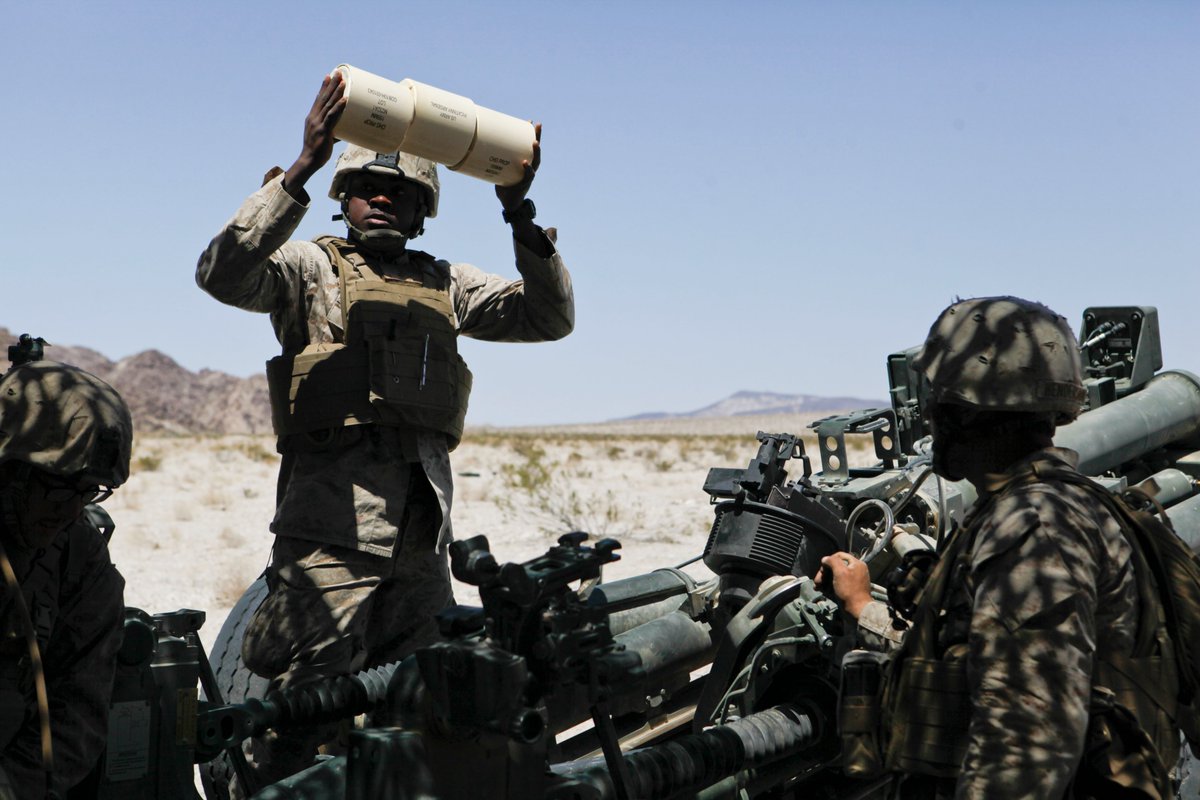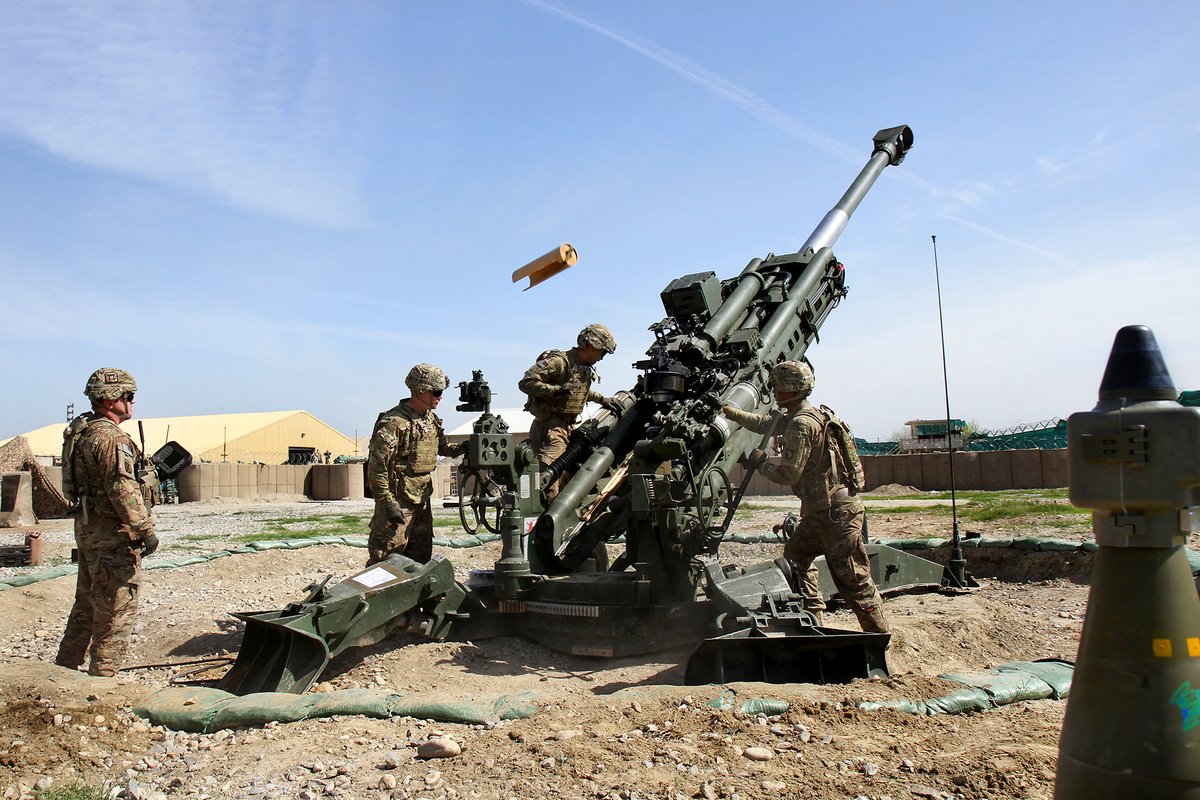I was asked how the M777 works.
A thread 🧵:
The M777 is a towed 155 mm howitzer with a gun crew of 8 soldiers or 10 marines.
1/n
A thread 🧵:
The M777 is a towed 155 mm howitzer with a gun crew of 8 soldiers or 10 marines.
1/n

There is a whole lot of battery and Battery Fire Direction Center (FDC) stuff that I will skip to focus on the operation of one M777.
When a fire mission is received a battery's M777 guns move to their firing positions.
2/n
When a fire mission is received a battery's M777 guns move to their firing positions.
2/n

Upon arrival half of a M777's crew emplaces the gun. Which means shovelling holes for the gun's spurs, raising the barrel, etc.
The less the gun moves after firing the faster the crew can fire the next projectile, so the spurs are buried deep in the earth.
3/n

The less the gun moves after firing the faster the crew can fire the next projectile, so the spurs are buried deep in the earth.
3/n


Meanwhile the rest of crew prepares the projectiles. Projectiles are transported with a lifting plug instead of a fuze.
A crew only prepares the projectiles for the current fire mission. Nothing worse than having to remove a fuze when you want to escape counter battery fire.
4/n

A crew only prepares the projectiles for the current fire mission. Nothing worse than having to remove a fuze when you want to escape counter battery fire.
4/n


Next step: unscrew the lifting plug and screw in the fuze.
There are a lot of fuzes: point detonating (super quick, delay) time (time, variable time), proximity, etc.
In this photo M739 fuzes (point detonating) are used.
5/n
There are a lot of fuzes: point detonating (super quick, delay) time (time, variable time), proximity, etc.
In this photo M739 fuzes (point detonating) are used.
5/n

With the projectiles ready it is time to unload the charges. The charges propel the projectiles out of the barrel and towards the enemy. The M777 uses the Modular Artillery Charge System (MACS), which comes in two colors: green and white.
6/n
6/n

M231 (Green): 1 or 2 charges for distances between 3-13 km
M232A1 (White): 3, 4, or 5 charges for distances between 7-24 km (standard projectiles) 8-30 km (base bleed projectiles)
MACS is also compatible with the PzH 2000 and FH70, both of which Ukraine is receiving too.
7/n
M232A1 (White): 3, 4, or 5 charges for distances between 7-24 km (standard projectiles) 8-30 km (base bleed projectiles)
MACS is also compatible with the PzH 2000 and FH70, both of which Ukraine is receiving too.
7/n

What is still missing are the primers.
Here we have an enthusiastic Australian Army loader with 4x M232A1 charges and 7x M82 primers in his vest.
The M82 is a cartridge that when struck will ignite the charges. No primer = no fire.
8/n
Here we have an enthusiastic Australian Army loader with 4x M232A1 charges and 7x M82 primers in his vest.
The M82 is a cartridge that when struck will ignite the charges. No primer = no fire.
8/n

Inserting each primer on its own would slow the gun crew down, so the primers are loaded into a magazine that sits at the back of the breech.
In the photo we see an unloaded magazine (with a blue stripe)
9/n
In the photo we see an unloaded magazine (with a blue stripe)
9/n

The M777 is in place, the projectiles are ready, the charges are laid out, the primers are loaded, time to sight the gun. First mount the optical sights, then adjust elevation and deflection to ensure the projectile hits we're it is intended to hit.
10/n
10/n

If you're using a proximity or time fuze then the projectile will detonate above ground, but only if you set the correct time or height.
Older fuzes were set by hand; modern fuzes by the PIAFS fuze setter (here used with M762 Electronic Time fuzes)
11/n
Older fuzes were set by hand; modern fuzes by the PIAFS fuze setter (here used with M762 Electronic Time fuzes)
11/n

Time to make some noise!
First throw the projectile onto the loading tray, which which will be lowered and align the projectile with the barrel. Now ram the projectile into the barrel until it is stuck, so it doesn't slide back and so that there is room for the charges.
12/n


First throw the projectile onto the loading tray, which which will be lowered and align the projectile with the barrel. Now ram the projectile into the barrel until it is stuck, so it doesn't slide back and so that there is room for the charges.
12/n



Time to load the charges.
Yell what charges you load and show the charges to the rest of the gun crew, because if you use too many or too few, the projectile will fall short or overshoot. If all is correct, then push the charges into the barrel.
13/n
Yell what charges you load and show the charges to the rest of the gun crew, because if you use too many or too few, the projectile will fall short or overshoot. If all is correct, then push the charges into the barrel.
13/n

If you load more than one charge - use the loading tray. If you load four or five charges - use a charge sleeve, place that on the loading tray, then push the charges in.
Don't forget to toss the charge sleeve theatrically away.
14/n



Don't forget to toss the charge sleeve theatrically away.
14/n




The loading tray is pushed back up and the charge loader closes the breech. Only he (!) is allowed to touch the breech mechanism, because when he loads the charges he sticks his hand into the barrel and if at that moment the breech comes down his hand is gone.
15/n
15/n
Almost there.
Once more the Gunner and Assistant Gunner check the gun's elevation and deflection, correct them if necessary, then report to the Gun Section Chief that everything is ready.
The charge loader is then ordered to push a lever to load a M82 primer.
16/n
Once more the Gunner and Assistant Gunner check the gun's elevation and deflection, correct them if necessary, then report to the Gun Section Chief that everything is ready.
The charge loader is then ordered to push a lever to load a M82 primer.
16/n

And the soldier operating the loading tray will now hook up the lanyard.
Pulling the lanyard will strike the primer, which will ignite the charges, which will propel the projectile out of the gun.
17/n
Pulling the lanyard will strike the primer, which will ignite the charges, which will propel the projectile out of the gun.
17/n

And showtime!
Well trained US Army and Marine gun crews can fire one round every 12-14 seconds.
(Also: have a look at this gun's Gunner, who is already checking his sights for the next fire mission.)
18/n
Well trained US Army and Marine gun crews can fire one round every 12-14 seconds.
(Also: have a look at this gun's Gunner, who is already checking his sights for the next fire mission.)
18/n

Now that you know how a M777 works, check out this video of a US Army M777 gun crew quickly firing 8 rounds.
19/n
19/n
If I made an error or omitted a step - please excuse, I haven't been to Grafenwöhr for some years.
If there are questions: feel free to ask.
20/n
If there are questions: feel free to ask.
20/n
Until today I didn't know this myself: Marine crews consist of 10x cannoneers, so that two 5x men crews can be formed to operate the M777A2 for 24 hours per day (albeit with a reduced rate of fire).
• • •
Missing some Tweet in this thread? You can try to
force a refresh


















